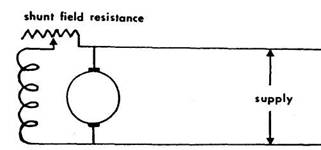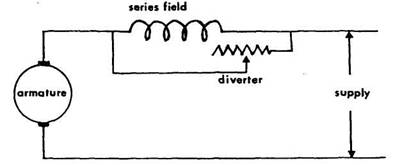Question
Discuss different methods of speed control of a
Change of current
through field pole windings is easy to achieve by use of a rheostat (variable
resistance) in series with a shunt motor field (Figure a) or a diverter for the
field of a series motor (Figure b).

Figure a. Shunt motor with field control of speed through a
rheostat

Figure. b. Series motor with field control of speed using a diverter
The weakening of the
magnetic fields of the poles by reducing field current has the inverse effect
of causing the motor to speed up. The explanation for this is that a weaker
field causes less back e.m.f. to be generated in the
armature conductors as they cut the flux. The resulting larger difference
between supply voltage and back e.m.f. means that
there is more effective voltage to increase armature current. This method is
useful for changing speed at the top end of the range, but it is not possible
to reduce speed below that which is obtained when full shunt-field current
flows. One limitation is that weakening of the magnetic fields of the poles
permits them to be more easily distorted by the rotating armature (armature
reaction). Greater advantage can be taken of field control if the machine has interpoles to limit the armature reaction.